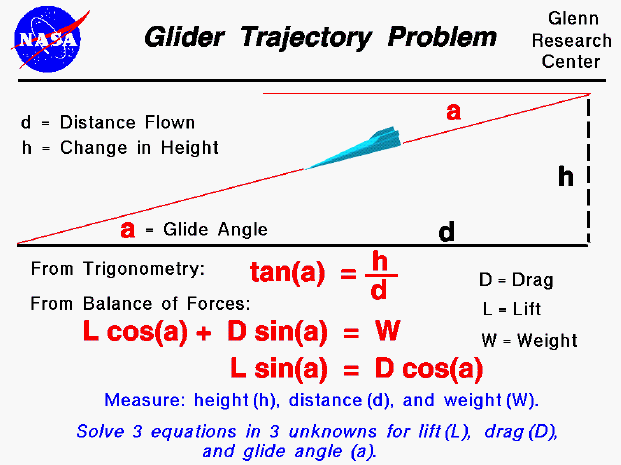

Displacement
Problem Set Activity
If so instructed by your teacher, print out a worksheet page for these problems.
If so instructed by your teacher, print out a worksheet page for these problems.

You will explore the trigonometric relationship tan (a) = h/d where a is the glide angle, h is the altitude of the plane, and d is the horizontal distance the plane will travel.
Problems:
- A full-sized glider has a glide angle of 2 degrees. If it loses 50 meters of altitude, how far would it move horizontally?
- A model glider moves horizontally 12 meters for every meter of altitude it loses. What is it's glide angle
- A model glider has a glide angle of 5 degrees. If it flies 23 meters horizontally, how much altitude will it lose?
- A full-sized glider has a glide angle of 5 degrees. If the altitude is 300 meters, will the glider make it to an airport 4,000 meters away?
- A full-sized glider loses 2 meters for every 38 meters it travels horizontally. What is it's glide angle?
- A model glider travels 57 meters horizontally after losing 5 meters of altitude. What is it's glide angle?
- A model glider loses 3 meters of altitude. If it has a glide angle of 4 degrees, how far did the glider travel horizontally?
- A full-sized glider lands 10,000 meters horizontally from where it began its downward diagonal path. If the glide angle is 3 degrees, what was the glider's altitude?
- A model glider has an average velocity of 2.2 m/s along it's downward diagonal path. After 10 seconds, the glider has lost 2 meters of altitude. What is the glider's glide angle and how far horizontally did it travel?
- A full-sized glider has a velocity of 36 m/s along it's downward diagonal path. If it has a glide angle of 4 degrees, how much altitude will it lose in 2 minutes? How far will it travel horizontally in that 2 minutes?
HOME
EDUCATOR RESOURCES | AERONAUTIC EDUCATIONAL RESOURCES | INTERNET ACCESS RESEARCH | ICING RESEARCH TUNNEL
BEGINNER'S GUIDE TO AERONAUTICS | FREE SOFTWARE | AERODYNAMICS INFORMATION | AERODYNAMICS PROBLEMS | PROPULSION INFORMATION |
PROPULSION PROBLEMS | FOILSIM INFORMATION | FOILSIM PROBLEMS | ENGINESIM INFORMATION | ENGINESIM PROBLEMS | ROCKETMODELER
AERONAUTICS LESSONS & ACTIVITIES | WIND TUNNEL WEB PAGES | AERONAUTS 2000 | VIDEOCONFERENCES WITH THE U.K.
EDUCATOR RESOURCES | AERONAUTIC EDUCATIONAL RESOURCES | INTERNET ACCESS RESEARCH | ICING RESEARCH TUNNEL
BEGINNER'S GUIDE TO AERONAUTICS | FREE SOFTWARE | AERODYNAMICS INFORMATION | AERODYNAMICS PROBLEMS | PROPULSION INFORMATION |
PROPULSION PROBLEMS | FOILSIM INFORMATION | FOILSIM PROBLEMS | ENGINESIM INFORMATION | ENGINESIM PROBLEMS | ROCKETMODELER
AERONAUTICS LESSONS & ACTIVITIES | WIND TUNNEL WEB PAGES | AERONAUTS 2000 | VIDEOCONFERENCES WITH THE U.K.
Please send any comments to:
Curator: Tom.Benson@grc.nasa.gov
Responsible Official: Kathy.Zona@grc.nasa.gov
Curator: Tom.Benson@grc.nasa.gov
Responsible Official: Kathy.Zona@grc.nasa.gov